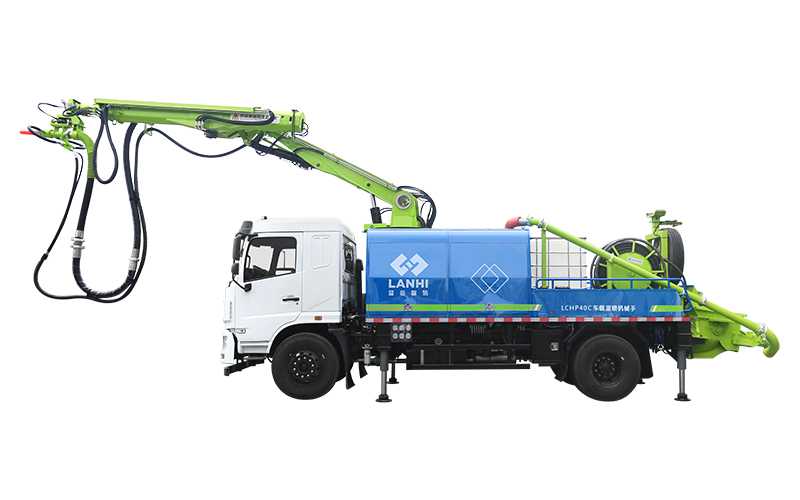Wet shotcrete robots, also known as concrete wet shotcrete sprayer, are advanced construction equipment widely used in railway and highway tunnels, slopes, water conservancy and hydropower tunnels and culverts, as well as subways and civil engineering projects. They utilize a hydraulic drive system, a high-strength robotic arm, and an intelligent control system to achieve precise and automated concrete spraying.

1. Working Principle of Wet Shotcrete Robots
A wet shotcrete robot uses a concrete pump to deliver mixed wet concrete to the spray gun at the end of the robotic arm. Simultaneously, an accelerator is added to ensure that the concrete quickly sets and solidifies after being sprayed onto the work surface, thereby supporting and reinforcing tunnels, slopes, and other work surfaces. During this process, the operator can precisely control the robot's motion trajectory, spray angle, and spray distance using a wireless remote control to ensure uniform concrete spraying across the work surface.
2. Advantages
① Efficient Automation: Utilizing fully automatic wireless remote control and intelligently controlling the addition of hydraulic accelerators, the robot can flexibly perform concrete spraying operations on a variety of work surfaces, greatly simplifying the operating procedures and improving work efficiency.
② Stable Performance: The equipment operates stably, is easy to operate, boasts high productivity, low rebound rate, and high construction quality and safety. It is suitable for construction in various geological conditions and effectively protects the health of construction workers.
③ Wide Range of Operational Coverage: The robotic arm is highly flexible and scalable, capable of full extension to cover various areas, including the tunnel vault, sidewalls, and invert, ensuring seamless operation and even concrete coverage across the construction surface.
④ Low Material Loss: Through precise spraying combined with a precise pressure control system, concrete rebound rate is significantly reduced, minimizing material waste, saving construction costs, and alleviating the burden of rebound material cleanup.
⑤ High Safety: Equipped with a dedicated engineering chassis and four-wheel drive system, it offers excellent maneuverability and stability, enabling safe operation on slippery, muddy, and complex road surfaces and in tunnel environments. Furthermore, it is equipped with an anti-overturning structure and multiple safety features to further ensure operator safety.
⑥ Adaptability to Complex Environments: Flexible adjustment of multiple parameters, including spraying distance and angle, ensures stable spraying operations, regardless of narrow tunnel sections or complex geological structures, providing construction teams with greater operational flexibility.
3. Application Areas
① Tunnel Engineering: In railway and highway tunnel construction, wet spraying robots are used for initial tunnel support, spraying concrete onto the tunnel walls to create a robust support structure, prevent tunnel collapse, and ensure construction safety and the smooth progress of subsequent projects.
② Water Conservancy and Hydropower Engineering: They can be used for lining construction of hydropower tunnels and culverts, as well as for spraying concrete reinforcement of dam slopes and channels, improving the stability and impermeability of water conservancy facilities.
③ Mining Engineering: During the excavation and support of mine tunnels, wet spraying robots can quickly and effectively spray concrete onto tunnel walls, preventing rock fall and ensuring safe mining operations.
④ Construction pit projects: For slope support in construction pits, wet spraying robots can spray concrete onto the slope surface, forming a protective layer that enhances slope stability and prevents earthwork collapse.
⑤ Military projects: In military construction projects, such as underground bunkers and air-raid shelters, wet spraying robots can be used for concrete spraying operations, improving the project's protective capabilities and durability.





